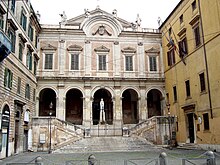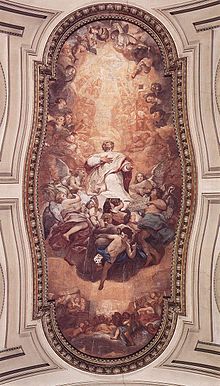Sant'Eusebio (Rome)
| Sant'Eusebio all'Esquilino | |
|---|---|
| Patronage : | St. Eusebius |
| Consecration day : | April 1, 1238 |
| Cardinal priest : | Daniel Cardinal DiNardo |
| Parish: | Sant'Eusebio all'Esquilino |
| Address: |
Via Napoleone III / Piazza Vittorio Emanuele II, 12A 00185 Roma |
Sant'Eusebio ( Latin Sancti Eusebii ), completely Sant'Eusebio all'Esquilino , is a church in Rome . It is considered to be one of the oldest titular churches of the Roman Catholic Church ( Titulus Eusebii ) and is today the parish church and station church for the Friday of the fourth week of fasting . She became known u. a. through the ceiling fresco in the central nave, executed by two German artists in the 18th century.
location
The church is in the XV. Roman Rione Esquilino on the inner-city section of the old Via Tiburtina , today on the northern corner of Piazza Vittorio Emanuele II about 200 meters east of Porta Esquilina .
History and building history
There are no reliable sources for the early Christian genesis of S. Eusebio. In particular, it is not clear which martyr or saint was the original church patron. Different sources on this, for example the Acta Sanctorum or the Martyrologium Hieronymianum , possibly assign different people to the Titulus Eusebii . Hugo Brandenburg assumes that the martyr pope Eusebius (308–309 / 10) was the first church patron. What is certain is that, according to the excavation results, the church stands on the remains of an ancient insula , according to legend, the house of a Christian who took sides against the Arian doctrine and was therefore locked up by his opponents in his own house, where he then starved should be, which from the assumed point in time does not want to fit the life dates of today's patron. Only a funerary inscription from 474 in the catacombs of Santi Marcellino e Pietro on the Via Labicana testifies that the person buried there was a priest of the church of Titulus Eusebii . This titulus is also mentioned in the synodal acts of 499 ; on the other hand, in the Synodal Acts of 599 it is the first time Titulus sancti Eusebii . The title of cardinal priest passed to Santi Andrea e Gregorio al Monte Celio in 1839 and was renewed in 1877.
A first church building over the ancient remains probably dates back to the time of Pope Sixtus III. (432-440). Work on it is known from Carolingian times. Around 1100 the early Christian building was replaced by a three-aisled basilica (approx. 32 × 19 m). It had a transept, flush with the outer walls, with a pedestal for the presbytery. The semicircular apse facing northwest was extremely small, so that it seems possible to take over from a previous building. Seven pairs of pillars with arcades separated the flat-roofed central nave from the side aisles. A sturdy support pillar was built in roughly in the middle of the nave. The triumphal arch was supported by two particularly artistically crafted marble columns with Corinthian capitals. In front of the basilica was an open vestibule with five arcades; on the two floors above there were four square and five arched windows.
This early 12th century basilica was built in the first quarter of the 13th century under Popes Honorius III. and Gregory IX. demolished and replaced by a new building. Honorius had the bell tower built, which today is the only original component of this era. Gregory consecrated the church on April 1, 1238, Maundy Thursday , to two saints, namely the current patron, St. Eusebius of Vercelli, and St. Vincent .
From 1294 the church belonged to the Order of the Coelestines . Restorations and minor construction work are known from the 16th and 17th centuries. In 1771 Carlo Fontana's son and pupil , Carlo Stefano Fontana , created the facade, built the portico and renovated the church in the baroque style. Apart from the campanile, only parts of the outer walls of the Romanesque basilica remained. Another part of the new building was financed with funds from Cardinal Enrico Enriquez shortly after 1750, the original columns of the old church were replaced by pillars. In 1785 the church passed from the Celestines to the Jesuits , who stayed there until 1870. Then the parish was established, which the church serves today.
facade
The facade of the portico is five-axis and two-story. A staircase climbs up from the forecourt to the portico and splits halfway up. The pillars of the five arches are presented with capitals with a Doric order . Above the cranked cornice, the pilasters between the windows are designed with capitals in an Ionic order ; the capitals contain festoons . The triangular gables above the windows are alternately concave and convex bulged or drawn in on the short sides. The architrave of the upper floor contains a dedication inscription. Above the central axis it is rounded up to form a coat of arms flanked by two garlands . Behind the upper floor rises the front side of the actual church building, designed as a simple triangular gable.
Interior and outfit
The interior furnishings of the early 13th century included a ciborium above the main altar, a schola cantorum with ambo, a confessio and a marble shrine with relics, a wall tabernacle in the presbytery and a marble throne in the curve of the apse. The church walls are said to have been painted or decorated with mosaics. It is believed that there was an apse mosaic on which Christ was depicted as the Lamb of God and the apostles in the form of twelve lambs. Towards the end of the 16th century, most of the old furnishings in the presbytery were removed.
Today the interior of the church is a three-aisled pillar basilica with a transverse building that is not extending beyond the rest of the church . A transversely oval dome without a drum rises above the crossing . The inscription on the lantern above the dome reads: “† DEO BEATE MARIAE ET CONFESSORI EVSEBIO AN. IVB. MDC “In the central nave, pilasters according to the Ionic order are presented to the pillars, in the side aisles according to the Tuscan order . The church is covered by a barrel vault with stitch caps, in which the eight windows are let under segmental arches. Today's church building is known for the central ceiling fresco . It depicts the apotheosis of St. Eusebius and is a very late example of illusionist painting. The performing artists, Anton Raphael Mengs and his brother-in-law Anton Maron , created it in 1755. They were based on the work of Antonio da Correggio . One of the angels - on the lower right-hand side - holds a sheet with the Greek inscription: OMOOYCIOC TO ΠATRI as a reference to the conflict with the Arians.
On the triumphal arch there are stuccoed angels with a coat of arms of Cardinal Enriquez, a reference to his promotion of the renewal of the church.
In the high altar, designed according to Onorio Longhi's designs, there are relics of the eponymous patron as well as of St. Orosius and St. Paulinus . The altar painting is the work of Baldassare Croce .
The transept contains opposing altars with altar leaves by Andreas Ruthard .
The choir stalls behind the high altar are richly crafted from walnut, created in 1587.
Animal blessing
On the Sunday next to January 17th, the commemoration day of Anthony the Great , animals, today mainly domestic animals, will be blessed in front of the church. Originally the blessing took place at the nearby church of Sant'Antonio Abate all'Esquilino , but was moved to Sant'Eusebio for reasons of space.
opening hours
The church is open Tuesday through Saturday from 7:30 am to 12:00 pm and from 5:00 pm to 7:00 pm. The opening times may differ in the summer months. Services are held in the church on Sundays.
Cardinal priest
literature
- Hugo Brandenburg : The early Christian churches in Rome from the 4th to the 7th century. Schnell & Steiner, Regensburg 2013, pp. 211f.
- Hans Georg Wehrens: Rome - The Christian sacred buildings from the 4th to the 9th century - A Vademecum . Herder, Freiburg 2016, pp. 259ff.
- Claudio Rendina: Le Chiese di Roma . Newton & Compton, Rome 2007, ISBN 978-88-541-0931-5 .
- Marco Bussagli (Ed.): Rome - Art & Architecture. Könemann, Cologne 1999, ISBN 3-8290-2258-1 .
- Anton Henze u. a .: Art guide Rome . Reclam, Stuttgart 1994, p. 170.
- Walther Buchowiecki : Handbook of the Churches of Rome. The Roman sacred building in history and art from early Christian times to the present. Volume 1, Hollinek Vienna 1967, pp. 685ff.
Individual evidence
- ^ Diocese of Rome
- ↑ Buchowiecki: Handbook of the Churches of Rome , p. 686f.
- ^ Brandenburg: The early Christian churches in Rome from the 4th to the 7th century. Schnell & Steiner, Regensburg 2013, p. 211.
- ↑ Buchowiecki: Handbook of the Churches of Rome , p. 686.
- ↑ Wehrens: Rome - The Christian sacred buildings from the 4th to the 9th century - A Vademecum . Freiburg 2016, pp. 259f.
- ^ Anne Glock: On the presbyter lists of the Roman synods of 487, 495 and 499 AD; in: Studies on the Roman Religion in Antiquity and Modern Times, edited by Christoph Auffarth and Jörg Rüppke, Wiesbaden 2002, pp. 173 and 176ff.
- ↑ Wehrens: Rome - The Christian sacred buildings from the 4th to the 9th century - A Vademecum . Freiburg 2016, p. 260.
- ^ Claudio Rendina: Le Chiese di Roma , p. 99.
- ↑ Buchowiecki: Handbook of the Churches of Rome , p. 687.
- ↑ Bussagli (Ed.): Rom - Art & Architecture , p. 576.
- ↑ Wehrens: Rome - The Christian sacred buildings from the 4th to the 9th century - A Vademecum . Freiburg 2016, p. 260f.
- ↑ Buchowiecki: Handbook of the Churches of Rome , p. 690.
- ↑ Anton Henze u. a .: Art guide Rome . Reclam, Stuttgart 1994, p. 170.
- ↑ Description at www.laboratorioroma.it (Italian)
Web links
Coordinates: 41 ° 53 ′ 46.8 " N , 12 ° 30 ′ 13.8" E




